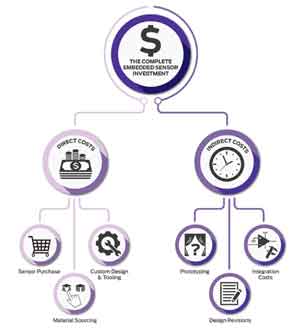
Considerations to Help Save on your Embedded Force Sensor Investment
Rob Podoloff, CTO, Tekscan, Inc.

 Rob Podoloff, CTO, Tekscan, Inc.
Rob Podoloff, CTO, Tekscan, Inc.As a decision maker in your company, you know that embedded sensor technologies come with a complex array of direct and indirect costs. First, there are the direct costs associated with sensor piece-price, material sourcing, and custom design and tooling expenses. Nevertheless, even if you find an affordable sensor solution, indirect costs from design revisions, because the sensor may not produce desired results at first, or prove difficult to mass produce, can derail a device’s path to market.
In the case of force-sensing technologies—an embedded sensor category that is loaded with different sensor forms and vendors—it can be easy to get lost in the multitude of options. However, there are a few considerations to have in mind when evaluating force sensor alternatives that may help you manage both direct and indirect costs.
COMMON EMBEDDED FORCE SENSORS USED TODAY
Load cells, strain gauges, and force-sensitive resistors (also known as piezoresistive sensors) are three of the most common force-sensing technologies embedded into devices today. Depending on the type of force feedback, the device needs to capture the component size, or power limitations, some sensing options may be better choices than others.
Load cells are generally the most well-known force sensor technology. They offer the highest level of precision among other force sensor types, and are an ideal choice for applications that need to obtain exact force measurements. Load cells tend to be bulky, expensive, and require significant power to operate, making them more challenging to embed into compact devices.
Strain gauges are another common force-sensing alternative and are much smaller in size than load cells. Unlike load cells, though, strain gauges measure force as a result of an indirect measurement correlated to the strain of fine conductive wires. Also, strain gauges may require complex electronics to operate, which can be expensive to implement on a large scale.
Load cells, strain gauges, and force-sensitive resistors (also known as piezoresistive sensors) are three of the most common force-sensing technologies embedded into devices today
Force-sensitive resistors consist of semi-conductive material sandwiched between two pieces of ultra-thin, flexible polyester. They are not as accurate as load cells, but force-sensitive resistors are effective for detecting and measuring relative change in force or applied load, capturing contact and/or touch, and also for identifying force thresholds to trigger an action. Because their flexible form factors, their affordability, and their ability to function on simple electronics, force-sensitive resistors have been successful in enhancing many different types of devices, without adding complexity to the design, or difficulty to the user.
 WHAT TO WATCH FOR WHEN EVALUATING FORCE SENSORS
WHAT TO WATCH FOR WHEN EVALUATING FORCE SENSORS
Every application offers its own unique challenges, so it may be possible to automatically rule out certain technologies from your device design. Even so, there are certain valuable aspects to look for no matter what force sensor type you choose.
1. Does the provider offer off-the-shelf sensor designs in low quantity?
As you begin investigating force sensor options, search for any low-cost, low-commitment evaluation options that may be available. Having the ability for your design engineers to experiment with the technology, without having to make a significant up-front investment, can help affirm or rule out sensor types while keeping cost- and time-efficient.
Some providers have online stores offering a wide array of sensor sizes, force ranges, and operating capabilities.
These are great to have during the prototyping/proof-of-concept design stage, especially if the application may need to function in challenging operating conditions (e.g. high temperature, high humidity, etc.). Specifically in the case of force-sensitive resistors, some standard sensor types can be trimmed or modified to fit into specific spaces.
Also, take note of any out-of-the-box development kits that can help make the integration process more efficient.
2. Consider the mechanical and electrical limitations of your design.
Smart devices that are both compact and power efficient will always be key features to customers. Naturally, embedding force-sensing capabilities into a device can prompt mechanical and electrical challenges to any device design.
From a mechanical perspective, an obvious appeal for some sensing technologies will be their ability to fit within or conform around tight space constraints. But another benefit may be the ability to connect the sensor to the device through different methods. This freedom helps reduce design revisions, or the need to design more electronic components to effectively power the sensor.
Sensor types that can prove superior linearity and repeatability will go a long way in becoming a successful feature in a design. An easy calibration process and the ability for the sensor to operate on simple circuitry, all contribute to a smoother integration process.
3. Does the provider offer a variety of value-added integration resources and expertise?
Most force sensor providers will say and do all of the right things at first, but taking a closer look at their history and capabilities may reveal some potentially costly surprises. It’s important to partner with a company that can demonstrate a history of success in assisting design engineers through the integration process.
Certain providers will have integration resource literature available for download off of their websites. These show that the company understands the integration process, and can be trusted to help your design team stay efficient.
SMART DECISIONS SAVE TIME, MONEY, AND STRESS
The old adage “you get what you pay for” takes on a much more complex meaning when evaluating embedded force-sensing technologies. Curiosity may be in the design engineer’s DNA, but as a major stakeholder in your company, keeping these key cost-saving tips in mind can help your design team stay within spec, within budget, and within deadline.
Read Also














